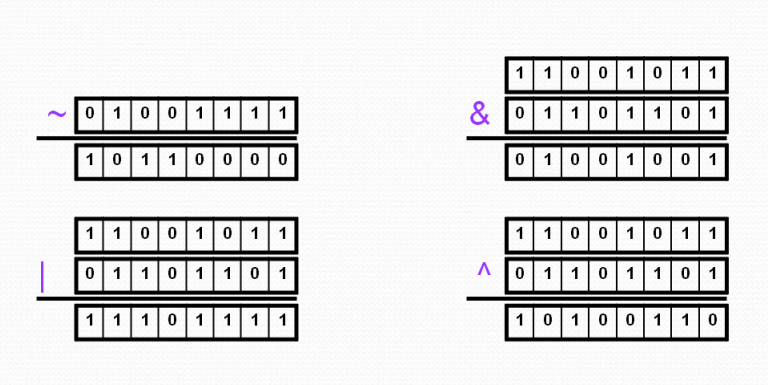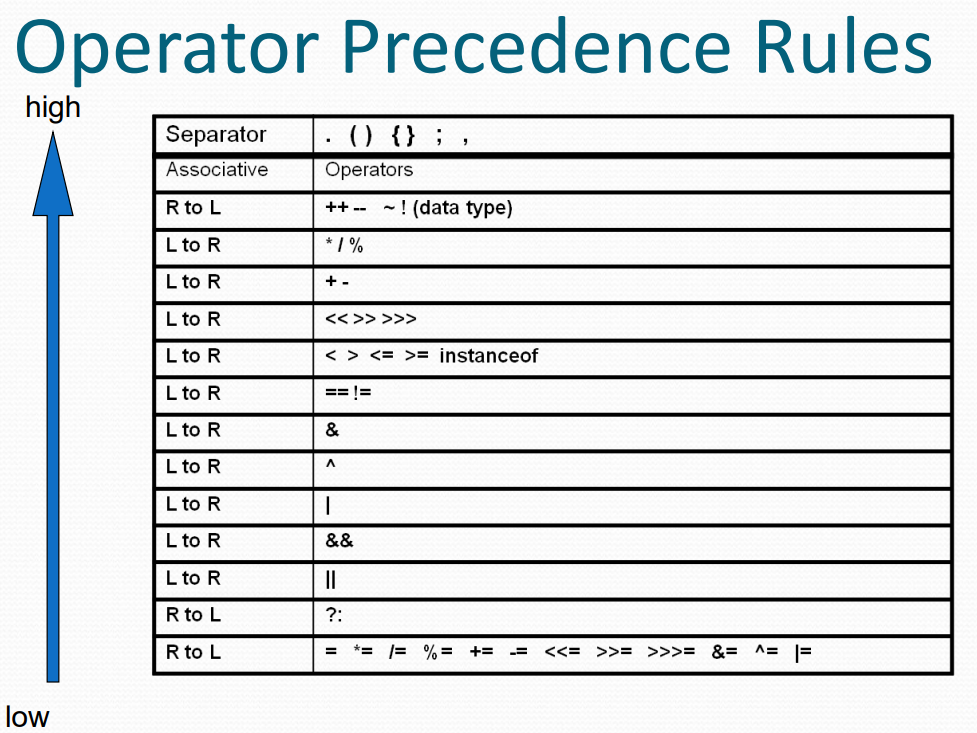Title: "[[Java-Programming-Essentials]]"
Author:
- AllenYGY
status: DONE
tags:
- NOTE
- Java
- Lec2
- Program
created: 2023-11-04T00:59
updated: 2024-05-31T01:02Java Programming Essentials
Identifiers and Naming
- A Java identifier must NOT start with a digit, and all the characters must be letters, digits, “$”or“_”
- Java is a case-sensitive language
- W_12, HelloWorld,_983, $bS5_c7 Correct
- 4W2, class, Data#, 98.3, Hell world Not Ok
Keywords
- new/const

Variable Declarations and Assignments
int numberOfBeans;
double myBalance, totalWeight;
Every variable in a Java program must be declared before it is used
Naming Conventions
- Camel Case
- Variable and Method names should begin with a lowercase letter. Indicate "word" boundaries with an uppercase letter and restrict the remaining characters to digits and lowercase letters:
- topSpeed bankRate1 timeOfArrival
- Class names should begin with an uppercase letter and, otherwise, adhere to the rules above:
- FirstProgram MyClass String
- Variable and Method names should begin with a lowercase letter. Indicate "word" boundaries with an uppercase letter and restrict the remaining characters to digits and lowercase letters:
Three kinds of variables
- Local variables
Local variables are declared (visible) in methods, constructors or blocks. No default value for local variables, therefore should be assigned an initial value before the first use.
局部变量(local variable)是在方法或代码块内部定义的变量,只能在该方法或代码块内部访问。它们的生命周期仅限于该方法或代码块的执行期间。局部变量必须先声明,然后才能使用。在声明时,可以指定变量的类型和初始值。例如:
public void exampleMethod() {
int x = 5; // x是一个局部变量,类型为int,初始值为5
System.out.println(x); // 输出5
}
- Instance variables
Instance variables are declared in a class, but outside a method, constructor or any block. Instance variables have default values, e.g., numbers – 0, Boolean – false,etc.
实例变量相当于该类的属性,需要 "new对象 "才能被调用。而且该变量不常驻内存,当这个类不再被使用时会java回收机制所释放。例如:
public class ExampleClass {
int x; // x是一个实例变量,初始值为0
String str = "hello"; // str是一个实例变量,初始值为"hello"
}
-
实例变量存在默认值:
- 数值类型(byte,short,int,long,float,double):0
- char类型:'\u0000'(空字符)
- boolean类型:false
- 引用类型(例如String):null
-
Class/static variables
Class/Static variables are declared with the static keyword in a class, but outside a method, constructor or blocks.
There would only be one copy of each class variable per class, regardless of how many objects are created from it. Default values are same with instance variables.
静态变量用 static字符修饰,随着类的加载而加载,静态变量存放在方法池中的静态区,可以直接通过"类名.变量名直接"调用,也可以通过类的对象调用。
public class ExampleClass {
static int x; // x是一个静态变量,初始值为0
static String str = "hello"; // str是一个静态变量,初始值为"hello"
}
int a = ExampleClass.x; // 通过类名访问静态变量x
String s = ExampleClass.str; // 通过类名访问静态变量str
Standard input and output (I/O)
- Standard output
System.out.println(); //Print a line to the standard output (screen)
System.out.print(); //Print something to the standard output (screen)
- Standard input
import java.util.Scanner;
Scanner input = new Scanner(System.in);
int a=input.nextInt();
String b=input.nextline();
Double c=input.nextDouble();
Data Types

primitive type
- numerical data type:
- integer: byte, short,int,long long num=8888888(l);
- floating point: float,double float num=8888888(f);
- character data type: char
- boolean data type: bool
- 小数默认是 double
- data range:

Reference data type
- class
- interface
- array
Variable Initialization
Type Casting
Arithmetic Expressions and Operators
- & (“and”), | (“or”), ^ (“xor”), ~ (“not”)
- n<<k n左移k位
- n>>k n右移k位


Java Packages
- Code libraries in Java are called packages.
A package is a collection of classes that is stored in a manner that makes it easily accessible to any program.
In order to use a class that belongs to a package, the class must be brought into a program using an import statement
Flow Control
- if-else, if, and switch statements.
- while, do-while, and for statements.
- A Boolean expression evaluates to either true or false -- used to control the flow
Condition statement
if(){}
else{}
switch() {case"": break;}
Loop statement
while(Boolean_Expression) {
Statement_1
Statement_2
Statement_Last
}
do {
Statement_1
Statement_2
Statement_Last
} while(Boolean_Expression);
for(initialization;Boolean_Expression;Update){
}
The break and continue Statements
- The break statement: break;
- When executed, the break statement ends the nearest enclosing switch or loop statement.
- The continue statement: continue;
- When executed, the continue statement ends the current loop body iteration of the nearest enclosing loop statement.
- Note that in a for loop, the continue statement transfers control to the update expression.
